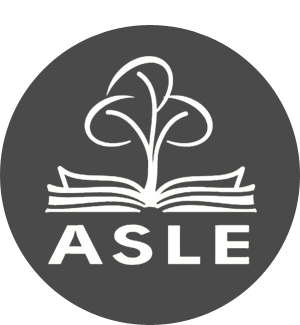Judges have announced the finalists for the 2023 ASLE Book Awards. The awards, in the categories of ecocriticism and environmental creative writing, were established in 2007 and have been given biennially to recognize excellence in the field.
Winners will be announced this June and celebrated at the Authors’ Reception at the 2023 Conference in Portland Oregon on July 10. These finalists are books authored or edited by ASLE and international affiliate members. Congratulations to our short-listed authors, read more about their books below.
ASLE Creative Writing Book Award Finalists
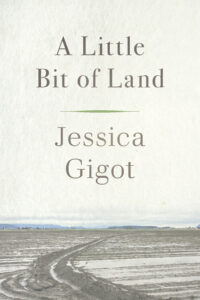 A Little Bit of Land by Jessica Gigot. Oregon State University Press, 2022.
A Little Bit of Land by Jessica Gigot. Oregon State University Press, 2022.
In A Little Bit of Land, Gigot explores the intricacies of small-scale agriculture in the Pacific Northwest, the changing role of women in this male-dominated industry, and questions of sustainability, economics, and health in our food system. Gigot alternates between describing the joys and challenges of small farm life and reflecting on her formative experiences outdoors and in classrooms throughout the region—from Ashland in southern Oregon to the Skagit Valley in Washington State. Throughout, she discovers what it means to find roots, start a family, and cultivate contentment in this unique corner of the world.
A Little Bit of Land is a moving memoir about falling in love with a place and all its inhabitants. It will be relished by readers interested in regenerative agriculture and anyone who is curious about what it means to care about the land.
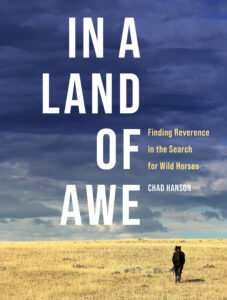 In a Land of Awe: Finding Reverence in the Search for Wild Horses by Chad Hanson. Broadleaf Books, 2022.
In a Land of Awe: Finding Reverence in the Search for Wild Horses by Chad Hanson. Broadleaf Books, 2022.
Through the lens of the wild mustang, social scientist and poet Chad Hanson gives us new ways to see and meaningfully engage our world as we enter new considerations about how we understand animals and our landscapes, our history, and ourselves. What is a wild animal? How do feelings of reverence reconnect us with nature? What can we learn from our wisdom traditions? And in the end, what would it look like if we managed public land with the common good in mind? With wisdom gathered from the histories of the American West, geography, philosophy, theology, and sociology, we meet awe anew. In the tradition of the great literary and nature writers, In a Land of Awe serves as a plea for what we stand to lose if we don’t find the courage to protect the planet’s most beautiful, and vulnerable, others.
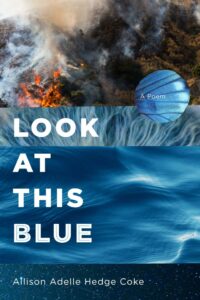 Look at This Blue by Allison Adelle Hedge Coke. Coffee House Press, 2022.
Look at This Blue by Allison Adelle Hedge Coke. Coffee House Press, 2022.
Interweaving elegy, indictment, and hope into a love letter to California, Look at this Blue examines America’s genocidal past and present to warn of of a future threatened by mass extinction and climate peril. Truths about what we have lost and have yet to lose permeate this book-length poem by American Book Award winner and Fulbright scholar Allison Adelle Hedge Coke. An assemblage of historical record and lyric fragments, these poems form a taxonomy of threatened lives—human, plant, and animal—in a century marked by climate emergency. Look at This Blue insists upon a reckoning with and redress of America’s continuing violence toward Earth and its peoples, as Hedge Coke’s cataloguing of loss crescendos into resistance.
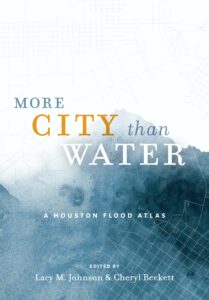 More City Than Water: A Houston Flood Atlas, edited by Lacy M. Johnson & Cheryl Beckett. University of Texas Press, 2022.
More City Than Water: A Houston Flood Atlas, edited by Lacy M. Johnson & Cheryl Beckett. University of Texas Press, 2022.
More City than Water brings together essays, conversations, and personal narratives from climate scientists, marine ecologists, housing activists, urban planners, artists, poets, and historians as they reflect on the human geography of a region increasingly defined by flooding. Both a literary and a cartographic anthology, More City than Water features striking maps of Houston’s floodplains, waterways, drainage systems, reservoirs, and inundated neighborhoods. Designed by University of Houston seniors from the Graphic Design program, each map, imaginative and precise, shifts our understanding of the flooding, the public’s relationship to it, and the fraught reality of rebuilding. Evocative and unique, this is an atlas that uncovers the changing nature of living where the waters rise.
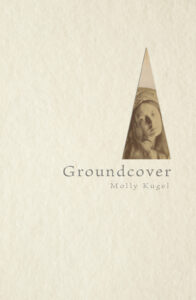 Groundcover by Molly Kugel. Tolsun Books, 2022.
Groundcover by Molly Kugel. Tolsun Books, 2022.
It could be said that in this age, the Anthropocene, we cannot discuss mourning without also mourning the earth. As poet and essayist Helen McDonald put it: “To talk about nature is to open yourself up to constant grief.” By marrying two seemingly dissimilar texts within vastly different disciplines, the 18th and 19th century herbarium, as well as a bereavement manual, the book attempts to discuss grief, the grief the speaker experiences over the death of her brother at a young age and the recent death of her father. To make sense of the cyclical nature of life and to seek answers, the speaker turns to the natural world, as well as turning to the women who came before her, the naturalists and artists who were endlessly mesmerized by the world around them, experiencing wonder and awe within the botanical and all of nature, understanding a biocentric unity, attempting to warn us.
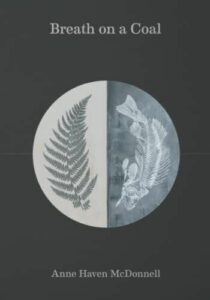 Breath on a Coal by Anne Haven McDonnell. Middle Creek Publishing, 2022.
Breath on a Coal by Anne Haven McDonnell. Middle Creek Publishing, 2022.
The exquisite poems in Anne Haven McDonnell’s Breath on a Coal are concerned with wholeness and intimacy and are made out of direct encounter with the more-than-human world, a world rendered with extraordinary sensitivity and directness. Bears, bullfrogs, roadrunners, bats, fireflies, salmon, elk, chanterelles, vultures, birches, mussels, and loons live in these poems, in all their innate radiance. In McDonnell’s hands, the precision of the mystery astonishes, takes your breath away: A slug “with its eyes of boneless horns” glistening along a black road like something “just born.” Later, a “sunlit blizzard of seed/blowing off cottonwoods.” The startling truth of “I forget sometimes/how trees look at me with the generosity/of water.” One moment, your attention is caught by riveting textures and meticulous observations of the living world; the next, you find yourself exhaling with an achingly clear grief. The poems in this collection breathe close enough to the coals that meaning flares up in every line. And life rises in all its pain and beauty from these pages. —Jenny George, author of The Dream of Reason
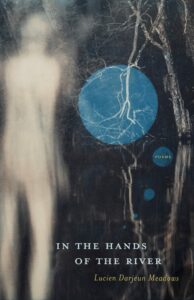 In the Hands of the River by Lucien Darjeun Meadows. Hub City Press, 2022
In the Hands of the River by Lucien Darjeun Meadows. Hub City Press, 2022
“What can we do but seek nectar where it blooms,” whispers the porous and questioning speaker of In the Hands of the River. In these haunting, layered poems, Lucien Darjeun Meadows affirms the interconnection of human and environmental identity. With delicate precision, In the Hands of the River subverts traditional poetic forms to show how a childhood for a queer boy of both Cherokee and European heritage happens within and outside dominant narratives of Appalachia.
This debut collection weaves ancestral and personal threads of trauma, reclamation, and survival into a multi-generational and multi-species tapestry that reaches from the distant stars visible in an Appalachian holler to the curl of a clover stem and the touch of the beloved, here and now. Moving across time, yet always grounded in place, these poems address the West Virginian landscape, both in exaltation and extraction, balanced with poems about the speaker’s own body, and emergent sense of queer identity, as “a boy made of shards.”
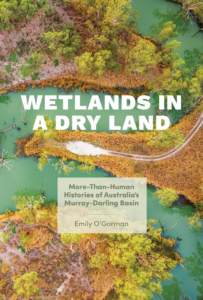 Wetlands in a Dry Land: More-than-human History of Australia’s Murray-Darling Basin by Emily O’Gorman. University of Washington Press, 2021.
Wetlands in a Dry Land: More-than-human History of Australia’s Murray-Darling Basin by Emily O’Gorman. University of Washington Press, 2021.
In the name of agriculture, urban growth, and disease control, humans have drained, filled, or otherwise destroyed nearly 87 percent of the world’s wetlands over the past three centuries. Unintended consequences include biodiversity loss, poor water quality, and the erosion of cultural sites, and only in the past few decades have wetlands been widely recognized as worth preserving. Emily O’Gorman asks, What has counted as a wetland, for whom, and with what consequences?
Using the Murray-Darling Basin—a massive river system in eastern Australia that includes over 30,000 wetland areas—as a case study and drawing on archival research and original interviews, O’Gorman examines how people and animals have shaped wetlands from the late nineteenth century to today. She illuminates deeper dynamics by relating how Aboriginal peoples acted then and now as custodians of the landscape, despite the policies of the Australian government; how the movements of water birds affected farmers; and how mosquitoes have defied efforts to fully understand, let alone control, them. Situating the region’s history within global environmental humanities conversations, O’Gorman argues that we need to understand wetlands as socioecological landscapes in order to create new kinds of relationships with and futures for these places.
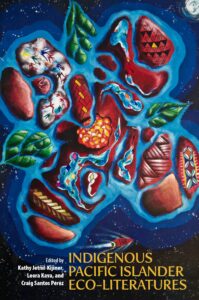 Indigenous Pacific Islander Eco-Literatures, edited by Kathy Jetñil-Kijiner, Leora Kava, and Craig Santos Perez. University of Hawai’i Press, 2022.
Indigenous Pacific Islander Eco-Literatures, edited by Kathy Jetñil-Kijiner, Leora Kava, and Craig Santos Perez. University of Hawai’i Press, 2022.
In this anthology of contemporary eco-literature, the editors have gathered an ensemble of a hundred emerging, mid-career, and established Indigenous writers from Polynesia, Melanesia, Micronesia, and the global Pacific diaspora. This book itself is an ecological form with rhizomatic roots and blossoming branches. Within these pages, the reader will encounter a wild garden of genres, including poetry, chant, short fiction, novel excerpts, creative nonfiction, visual texts, and even a dramatic play—all written in multilingual offerings of English, Pacific languages, pidgin, and translation. Seven main themes emerge: “Creation Stories and Genealogies,” “Ocean and Waterscapes,” “Land and Islands,” “Flowers, Plants, and Trees,” “Animals and More-than-Human Species,” “Climate Change,” and “Environmental Justice.” This aesthetic diversity embodies the beautiful bio-diversity of the Pacific itself.
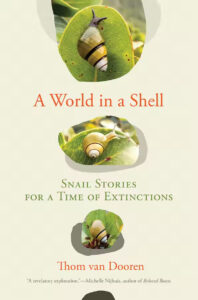 A World in a Shell: Snail Stories for a Time of Extinctions by Thom van Dooren. MIT Press, 2022.
A World in a Shell: Snail Stories for a Time of Extinctions by Thom van Dooren. MIT Press, 2022.
In this time of extinctions, the humble snail rarely gets a mention. And yet snails are disappearing faster than any other species. In A World in a Shell, Thom van Dooren offers a collection of snail stories from Hawai’i—once home to more than 750 species of land snails, almost two-thirds of which are now gone. Following snail trails through forests, laboratories, museums, and even a military training facility, and meeting with scientists and Native Hawaiians, van Dooren explores ongoing processes of ecological and cultural loss as they are woven through with possibilities for hope, care, mourning, and resilience.
ASLE Ecocritical Book Award Finalists
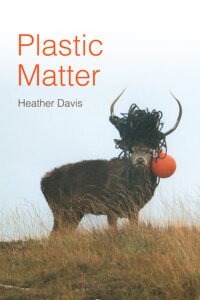 Plastic Matter by Heather Davis. Duke University Press, 2022.
Plastic Matter by Heather Davis. Duke University Press, 2022.
Plastic is ubiquitous. It is in the Arctic, in the depths of the Mariana Trench, and in the high mountaintops of the Pyrenees. It is in the air we breathe and the water we drink. Nanoplastics penetrate our cell walls. Plastic is not just any material—it is emblematic of life in the twentieth and twenty-first centuries. In Plastic Matter Heather Davis traces plastic’s relations to geology, media, biology, and race to show how matter itself has come to be understood as pliable, disposable, and consumable. The invention and widespread use of plastic, Davis contends, reveals the dominance of the Western orientation to matter and its assumption that matter exists to be endlessly manipulated and controlled by humans. Plastic’s materiality and pliability reinforces these expectations of what matter should be and do. Davis charts these relations to matter by mapping the queer multispecies relationships between humans and plastic-eating bacteria and analyzing photography that documents the racialized environmental violence of plastic production. In so doing, Davis provokes readers to reexamine their relationships to matter and life in light of plastic’s saturation.
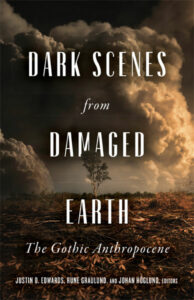 Dark Scenes from Damaged Earth: The Gothic Anthropocene edited by Justin D. Edwards, Rune Graulund, and Johan Höglund. University of Minnesota Press, 2022.
Dark Scenes from Damaged Earth: The Gothic Anthropocene edited by Justin D. Edwards, Rune Graulund, and Johan Höglund. University of Minnesota Press, 2022.
What can the Gothic teach us about our current geological era? More than just spooky, moonlit castles and morbid graveyards, the Gothic represents a vibrant, emergent perspective on the Anthropocene. In this volume, more than a dozen scholars move beyond longstanding perspectives on the Anthropocene—such as science fiction and apocalyptic narratives—to show that the Gothic offers a unique (and dark) interpretation of events like climate change, diminished ecosystems, and mass extinction.
Embracing pop cultural phenomena like True Detective, Jaws, and Twin Peaks, as well as topics from the New Weird and prehistoric shark fiction to ruin porn and the “monstroscene,” Dark Scenes from Damaged Earth demonstrates the continuing vitality of the Gothic while opening important new paths of inquiry. These essays map a genealogy of the Gothic while providing fresh perspectives on the ongoing climate chaos, the North/South divide, issues of racialization, dark ecology, questions surrounding environmental justice, and much more.
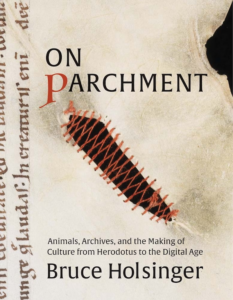 On Parchment: Animals, Archives, and the Making of Culture from Herodotus to the Digital Age by Bruce Holsinger. Yale University Press, 2023.
On Parchment: Animals, Archives, and the Making of Culture from Herodotus to the Digital Age by Bruce Holsinger. Yale University Press, 2023.
For centuries, premodern societies recorded and preserved much of their written cultures on parchment: the rendered skins of sheep, cows, goats, camels, deer, gazelles, and other creatures. These remains make up a significant portion of the era’s surviving historical record. In a study spanning three millennia and twenty languages, Bruce Holsinger explores this animal archive as it shaped the inheritance of the Euro-Mediterranean world, from the leather rolls of ancient Egypt to the Acts of Parliament in the United Kingdom.
Holsinger discusses the making of parchment past and present, the nature of the medium as a biomolecular record of faunal life and environmental history, the knotty question of “uterine vellum,” and the imaginative role of parchment in the works of St. Augustine, William Shakespeare, and a range of Jewish rabbinic writers of the medieval era. Closely informed by the handicraft of contemporary makers, painters, and sculptors, the book draws on a vast array of sources—codices and scrolls, documents and ephemera, works of craft and art—that speak to the vitality of parchment across epochs and continents. At the center of On Parchment is the vexed relationship of human beings to the myriad slaughtered beasts whose remains make up this vast record: a relationship of dominion and compassion, of brutality and empathy.
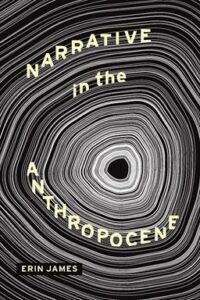 Narrative in the Anthropocene by Erin James. The Ohio State University Press, 2022.
Narrative in the Anthropocene by Erin James. The Ohio State University Press, 2022.
In Narrative in the Anthropocene, Erin James poses two complementary questions: What can narrative teach us about our current geological epoch, defined and marked by the irrevocable activity of humans on the Earth’s geology and ecosystems? and What can our current geological epoch teach us about narrative? Drawing from a wide range of sources—including Jane Austen’s Mansfield Park, Maria Popova’s collective biography Figuring, Richard McGuire’s graphic novel Here, Indigenous and Afrofuturist speculative fiction, and more—James argues that a richer understanding of the forms and functions of narrative in the Anthropocene provides us with invaluable insight into how stories shape our world. At the same time, she contends that the Anthropocene alters the very nature of narrative. Throughout her exploration of these themes, James lays the groundwork for an “Anthropocene narrative theory,” introducing new modes of reading narrative in the Anthropocene; new categories of narrative time, space, narration, and narrativity; and a new definition of narrative itself as a cognitive and rhetorical tool for purposeful worldbuilding.
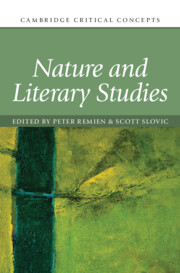 Nature and Literary Studies edited by Peter Remien and Scott Slovic. Cambridge University Press, 2022.
Nature and Literary Studies edited by Peter Remien and Scott Slovic. Cambridge University Press, 2022.
Nature and Literary Studies offers a broad and accessible overview of one of the most important and contested keywords in modern literary studies. Drawing together the work of leading scholars of a variety of critical approaches, historical periods, and cultural traditions, the book examines nature’s philosophical, theological, and scientific origins in literature, as well as how literary representations of nature evolved in response to colonialism, industrialization, and new forms of scientific knowledge. Surveying nature’s diverse applications in twenty-first-century literary studies and critical theory, the volume seeks to reconcile nature’s ideological baggage with its fundamental role in fostering appreciation of nonhuman existence and agency. Including chapters on wilderness, pastoral, gender studies, critical race theory, and digital literature, the book is a valuable resource for students and professors seeking to understand nature’s role in the environmental humanities.
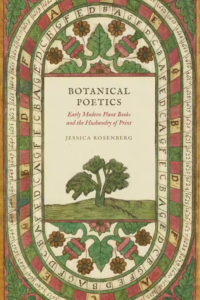 Botanical Poetics: Early Modern Plant Books and the Husbandry of Print by Jessica Rosenberg. University of Pennsylvania Press, 2022.
Botanical Poetics: Early Modern Plant Books and the Husbandry of Print by Jessica Rosenberg. University of Pennsylvania Press, 2022.
During the middle years of Queen Elizabeth’s reign, the number of books published with titles that described themselves as flowers, gardens, or forests more than tripled. During those same years, English printers turned out scores of instructional manuals on gardening and husbandry, retailing useful knowledge to a growing class of literate landowners and pleasure gardeners. Both trends, Jessica Rosenberg shows, reflected a distinctive style of early modern plant-thinking, one that understood both plants and poems as composites of small pieces—slips or seeds to be recirculated by readers and planters.
Botanical Poetics brings together studies of ecology, science, literary form, and the material text to explore how these developments transformed early modern conceptions of nature, poetic language, and the printed book. Drawing on little-studied titles in horticulture and popular print alongside poetry by Shakespeare, Spenser, and others, Rosenberg reveals how early modern print used a botanical idiom to anticipate histories of its own reading and reception, whether through replanting, uprooting, or fantasies of common property and proliferation. While our conventional narratives of English literary culture in this period see reading as an increasingly private practice, and literary production as more and more of an authorial domain, Botanical Poetics uncovers an alternate tradition: of commonplaces and common ground, of slips of herbs and poetry circulated, shared, and multiplied.
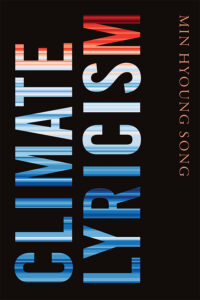 Climate Lyricism by Min Hyoung Song. Duke University Press, 2022.
Climate Lyricism by Min Hyoung Song. Duke University Press, 2022.
In Climate Lyricism Min Hyoung Song articulates a climate change-centered reading practice that foregrounds how climate is present in most literature. Song shows how literature, poetry, and essays by Tommy Pico, Solmaz Sharif, Frank O’Hara, Ilya Kaminsky, Claudia Rankine, Kazuo Ishiguro, Teju Cole, Richard Powers, and others help us to better grapple with our everyday encounters with climate change and its disastrous effects, which are inextricably linked to the legacies of racism, colonialism, and extraction. These works employ what Song calls climate lyricism—a mode of address in which a first-person “I” speaks to a “you” about how climate change thoroughly shapes daily life. The relationship between “I” and “you” in this lyricism, Song contends, affects the ways readers comprehend the world, fostering a model of shared agency from which it can become possible to collectively and urgently respond to the catastrophe of our rapidly changing climate. In this way, climate lyricism helps to ameliorate the sense of being overwhelmed and feeling unable to do anything to combat climate change.
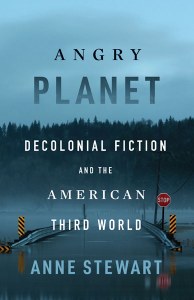 Angry Planet: Decolonial Fiction and the American Third World by Anne Stewart. University of Minnesota Press, 2022.
Angry Planet: Decolonial Fiction and the American Third World by Anne Stewart. University of Minnesota Press, 2022.
How might we understand an earthquake as a complaint, or erosion as a form of protest—in short, the Earth as an angry planet? Many novels from the end of the millennium did just that, centering around an Earth that acts, moves, shapes human affairs, and creates dramatic, nonanthropogenic change.
In Angry Planet, Anne Stewart uses this literature to develop a theoretical framework for reading with and through planetary motion. Typified by authors like Colson Whitehead, Octavia Butler, and Leslie Marmon Silko, whose work anticipates contemporary critical concepts of entanglement, withdrawal, delinking, and resurgence, angry planet fiction coalesced in the 1990s and delineated the contours of a decolonial ontology. Stewart shows how this fiction brought Black and Indigenous thought into conversation, offering a fresh account of globalization in the 1990s from the perspective of the American Third World, construing it as the era that first made connections among environmental crises and antiracist and decolonial struggles.
